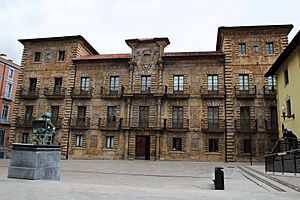Camposagrado Palace (Avilés) facts for kids
The Camposagrado Palace is a beautiful old building in Avilés, a town in Asturias, Spain. It was built in the special Baroque style of the 1600s. This grand palace stands where an even older medieval building once was. For many years, it was home to a noble family called the Marquises of Camposagrado. Later, it became a place for soldiers to stay. In the 1900s, parts of it were used as shops. Today, after being carefully fixed up, it is home to the School of Art for the Principality of Asturias.
Contents
History of Camposagrado Palace
The Camposagrado Palace was likely designed by an architect named Francisco Menéndez Camina. He worked on it between 1693 and 1696. The palace was built on the remains of an even older building. This older building belonged to the powerful Las Alas family. The wife of the first Marquis of Camposagrado, Eulalia de las Alas Carreño, was from this family. In 1661, Gutierre Bernaldo de Quirós received the title of Marquis of Camposagrado.
Palace Expansion and Design
The palace was made bigger in two main directions. The northern part of the palace was built towards the sea. This side was meant for defense and reached the old city walls. The northern side, facing Pier Park, has a special open porch called a loggia. This design was popular in the Renaissance period. It allowed people to watch the port from the palace.
The southern part of the palace was built to look grand and beautiful. It opened onto a plaza, letting people in town admire the building. This side faces the Plaza de Camposagrado. It has two square towers on each side of a central building. This style was very common for noble families in Asturias. The palace has many balconies and fancy window frames. It also features pairs of columns in different styles. These include Tuscan, Corinthian, and Solomonic designs. The most important part of the southern side is the family's coat of arms. It is placed on the middle balcony on the top floor.
Changes Over the Years
During the 1700s, the palace had several repairs and changes. In 1723, a person named Mauritius Haedo did some small repairs. Later, in 1774, a local stonework expert, Pedro Solis, was hired. He fixed the gallery, some broken stones, and pipes. His contract also mentioned that Francisco Pruneda Cañal was building a mill house for the Marquis.
The 1800s were a difficult time for the palace. During the Peninsular War, it was used by Napoleon's soldiers. Later, it housed Asturian troops. The palace walls were damaged between 1818 and 1821. Openings were made in the gallery arches to connect with the parapet. In the 1900s, the owner, Eladio Fernández Carreño, wanted to make changes inside. He planned to create stores for businesses. Because the building was historically important, he needed approval for his plans. He was stopped from some ideas, but the lower part of the palace did become shops.
Restoration and Current Use
On May 27, 1955, the Camposagrado Palace was declared a Cultural Monument. This means it is a very important historical building. The Avilés City Council decided to buy the palace in 1999. They started a big project to fix it up in 2002. The outside stonework was mostly saved, even though it was damaged. However, the inside of the palace was almost completely ruined. Only the grand staircase remained, along with parts of some wooden ceilings. The city council worked hard to restore both the inside and outside of the palace.
Today, the beautiful Camposagrado Palace is home to the School of Art. It is managed by the Ministry of Education and Science of the Principality of Asturias.
See also
 In Spanish: Palacio de Camposagrado (Avilés) para niños
In Spanish: Palacio de Camposagrado (Avilés) para niños


